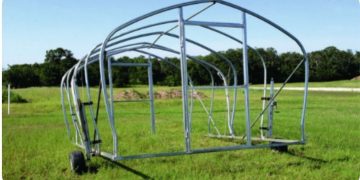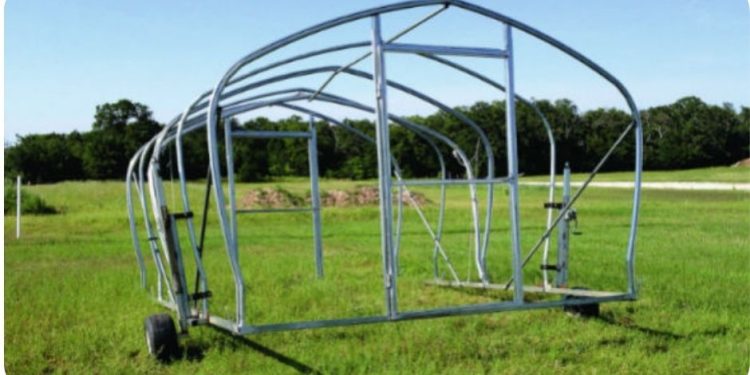Hoop houses (high tunnels) have long been used by agricultural producers to extend the growing season and to establish crops earlier as compared to crops grown in the field.
A growing trend in the horticulture industry is the idea of a moveable hoop house that would provide more flexibility and versatility, and allow a grower to establish multiple crops within a year.
Ardmore, Oklahoma-based Noble Foundation research horticulturist Charles Rohla received a two-year, $144,880 specialty crop block grant from USDA and the Oklahoma Department of Agriculture, Food and Forestry to conduct a research project with mobile hoop houses. The grant will support Rohla in evaluating the potential benefits of the moveable hoop houses compared to traditional field production and permanent hoop house structures.
“This project will benefit specialty crop growers throughout the nation who are interested in growing both summer and winter crops utilizing protected structures,” Rohla said. “Many producers aren’t familiar with moveable hoop houses, so this study will allow growers to see the benefits of utilizing the entire growing season of crops.”
The long-term goal of the study is to evaluate the moveable houses and to educate interested growers on the benefits of using the houses in their cropping systems. The project will examine the length of the growing season and total production of selected vegetables produced in each system. It will provide the data to determine if these structures allow growers to maximize the growing season of chosen crops while still allowing them to establish additional crops that can benefit from these structures.
The research is part of the Noble Foundation’s Center for Pecan and Specialty Agriculture (CPSA). CPSA conducts research and demonstrations that will enhance production as well as educate producers and the community on opportunities in specialty agriculture. Beginning in 2017, field days will be conducted during the growing season to inform and educate producers about the technology being used.
“Interest in specialty agriculture continues to rise as the population increases, agricultural land availability decreases and consumers become more interested in food production,” said Rohla, who manages CPSA. “This growing trend has created the opportunity for the Noble Foundation to further examine this critical area of agriculture.
“This started from interest from several growers who have been looking at ways of maximizing their crops in their fields,” Rohla said. “They were already using permanent high tunnels or hoop houses and wanted to determine whether there was a way to move structures to maximize the crop.”
Rohla said some of the moveable structures currently on the market are moved with rollers or tracks, “the disadvantage being they only move in one direction. A lot of growers have really small acreage and don’t have the luxury of having large areas where they can put them in, and it’s fairly costly.”
Rohla worked with Leon’s Greenhouses in Kingston, Oklahoma, to begin manufacturing hoop houses with a more diverse wheel assembly that attaches to the house.
“The mechanism can be used to move the hoop house and provide better access in the field,” he said. “It’s essentially a small, portable building with tires attached to the side. We went through about six different prototypes of how to lift the house, secure it and drive with it – that’s all part of the study.”
He said the project looked at currently available moveable structures, each one having a different type of mechanism to lift it off the ground.
Products that have been available have a solid end wall with a piece of metal or some type of bracket that stabilizes the structure.
“They’re a little bit different than ours,” he said. “One uses a piece of angle iron set up in the air and the roller goes on there back and forth. Another one uses round tubing that sticks in the ground. Another one sits on tubing that can be pulled back and forth. The track limits access and the things you can do around that structure.”
A major concern is potential damage caused by structures that make contact with the plant when the hoop house is being moved, particularly taller plants such as tomatoes.
He said the houses his project is working to design will not come in contact with the plant upon removal, and could be anchored in the ground with ground anchors. They could be adaptable to plastic covering or shade cloth.
The structures are 14 feet by 40 feet, but the researchers are looking at ways to put them end- to-end to create a larger structure for those more interested in commercial production.
Rohla said one vegetable grower in the Midwest that has a moveable structure that is 22 feet wide and 96 feet long.
“It takes him two hours to move it,” he said. “Our 14 by 40s can be moved and anchored down in 15 minutes. Several together could be moved with ease and create larger structures.”
While others would require a larger tractor to be moved, the product Rohla is involved in developing could be moved with a lawn tractor, or in some cases with a few crew members.
Sloan Greenhouses is already selling and installing the product, and moveable structures are going up in Oklahoma and Texas, Rohla said.
“Anything typically grown in high tunnels would work with this,” he said. “We’re also looking at work done by the University of Arkansas growing fruits in high tunnels. We’re looking at some of that using moveable structures.”
The moveable tunnel approach could help growers better manage late freezes to protect peaches or other crops otherwise sensitive to cold. High tunnel use for fruits also requires different tree pruning and training methods.
The benefits of moveable tunnels for smaller growers provide tangible perks, he said.
“With a small piece of land, you can utilize it better to move it anywhere it’s needed to protect a crop. With a standard permanent structure, you’re only working with what’s in that structure itself at the time.”
It also enables growers to better manage soil conditions, disease pressure and crop rotation, he said.
In the study, researchers are comparing use of a moveable structure versus a permanent house, with a look at the economics, labor use and production benefits.
“We’re looking to help growers justify the cost of the structure,” Rohla said. “It should be labor-saving. If you’re spraying a lot of pests, these (hoop houses) could alleviate pest pressure. Diseases for vegetables are spread through rain splashing, and with a structure you won’t have rain occurring inside.”
Season extension is another big selling point for the structures.
“With a permanent structure, you don’t get the full benefit of the growing season. You have to terminate a crop to get the next crop started. You can keep growing with the moveable ones. There is a longer growing season available when growing with these houses.
“My gut feeling is you could get maybe two or three additional crops in compared to the permanent structure,” Rohla said.
The research work is part of the 70-year-old Samuel Roberts Noble Foundation, an independent, nonprofit institute conducting plant science research, plant breeding and agricultural programs to enhance agricultural productivity. The foundation directors believe the work influences agriculture on an international basis. The organization also provides grants to nonprofit charitable, educational and health organizations.
“Our mission is to assist farmers with their goals to stay on the farm,” Rohla said. “We work hand in hand with producers, and the southern Great Plains is where we’ve traditionally been focused. Within the (CPSA), we’re developing an educational and demonstration farm to educate producers of 200 acres or less on anything they can do on that land. If their interest is in commercial production, we’ll show them what can be produced – that’s something we’ll assist growers with – all the way down to backyard farming.
“Our focus is mainly research for the agricultural commodities in the southern Great plains, north Texas and southern Oklahoma,” he said. “There’s been a change in the farming community with a lot of non-ag people moving to the country and buying small acreage. We want to be able to assist the grower.”
— Gary Pullano, associate editor

































